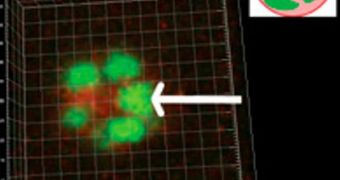Scientists with the US Department of Energy's (DOE) Lawrence Berkeley National Laboratory (Berkeley Lab) announce the discovery of a new type of circular cellular motion, exhibited by cells in the breast tissue. This type of movement is apparently essential for forming acini.
These are spherical structures that develop in the mammary gland, and they are absolutely essential to the good development of the breast and its health. What the Berkeley Lab team discovered was that cells tend to undergo a circular motion of sorts in order to trigger the formation of the spherical acini.
This was previously unknown, and investigators say that they could use the data to develop new therapies against conditions such as cancer. In addition, the study is bound to help investigators gain a deeper insight into how these acini influence overall mammary health.
Scientists with the team named the type of movement they saw “coherent angular motion,” and shortened it to CAMo. Without it, the acini sphere cannot form. This would lead immediately to a host of undesired effects such as loss of structural integrity, random motions and the development of cancer.
Details of the new research were published in the latest issue of the esteemed journal Proceedings of the National Academy of Sciences (PNAS), in a paper called “Coherent angular motion in the establishment of multicellular architecture of glandular tissue.”
“What is most exciting to me about this stunning discovery is that it may finally give us a handle by which to discover the physical laws of cellular motion as they apply to biology,” Berkeley Lab Life Sciences Division distinguished scientist Mina Bissell explains.
In addition to being a corresponding author of the PNAS paper, Bissell is also a global authority on breast cancer. She conducted the study with postdoctoral physicist Kandice Tanner, Hidetoshi Mori, Rana Mroue and Alexandre Bruni-Cardoso, who are all members of her Berkeley Lab research team.
“Without CAMo, the cells lose their way and do not form structures that allow mammary cells to make and secrete milk. In order to form a polarized sphere, the cells have to be properly oriented so that certain components are up and certain components are down,” Tanner explains.
“The CAMo rotation provides the cells with this orientation,” the investigator concludes. Funds for the new investigation came from the National Cancer Institute, the DOE Office of Science and the Department of Defense Breast Cancer Program.

 14 DAY TRIAL //
14 DAY TRIAL //